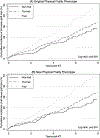Revision of frailty assessment in kidney transplant recipients: Replacing unintentional weight loss with CT-assessed sarcopenia in the physical frailty phenotype
- PMID: 34953170
- PMCID: PMC8983565
- DOI: 10.1111/ajt.16934
Revision of frailty assessment in kidney transplant recipients: Replacing unintentional weight loss with CT-assessed sarcopenia in the physical frailty phenotype
Abstract
Kidney transplantation (KT) experts did not support the use of subjective unintentional weight loss to measure shrinking in the physical frailty phenotype (PFP); a clinically feasible and predictive measure of shrinking is needed. To test whether unintentional weight loss could be replaced by an assessment of sarcopenia using existing CT scans, we performed a prospective cohort study of adult KT recipients with original PFP (oPFP) measured at admission (December 2008-February 2020). We ascertained sarcopenia by calculating skeletal muscle index from available, clinically obtained CTs within 1-year pre-KT (male < 50 cm2 /m2 ; female < 39 cm2 /m2 ) and combined it with the original four components to determine new PFP (nPFP) scores. Frailty was classified by frailty score: 0: non-frail; 1-2: pre-frail; ≥3: frail. Mortality and graft loss hazard ratios (HRs) were estimated using adjusted Cox proportional hazard models. Model discrimination was quantified using Harrell's C-statistic. Among 1113 recipients, 18.6% and 17.1% were frail by oPFP and nPFP, respectively. Compared to non-frail recipients, frail patients by either PFP had higher risks of mortality (oPFP HR = 1.67, 95% CI: 1.07-2.62, C = 0.710; nPFP HR = 1.68, 95% CI: 1.06-2.66, C = 0.710) and graft loss (oPFP HR = 1.67, 95% CI: 1.17-2.40, C = 0.631; nPFP HR = 1.66, 95% CI: 1.15-2.40, C = 0.634) with similar discriminations. oPFP and nPFP are equally useful in risk prediction for KT recipients; oPFP may aid in screening patients for pre-KT interventions, while nPFP may assist in nuanced clinical decision-making.
Keywords: clinical research/practice; epidemiology; geriatrics; graft survival; kidney transplantation/nephrology; patient survival.
© 2021 The American Society of Transplantation and the American Society of Transplant Surgeons.
Conflict of interest statement
DISCLOSURE
The authors of this manuscript have no conflicts of interest to disclose as described by the
Figures



Comment in
-
The physical frailty phenotype: Not ready for implementation.Am J Transplant. 2022 Sep;22(9):2276. doi: 10.1111/ajt.17025. Epub 2022 Mar 21. Am J Transplant. 2022. PMID: 35285138 No abstract available.
-
Moving toward clinical implementation of the physical frailty phenotype in kidney transplantation.Am J Transplant. 2022 Sep;22(9):2277-2278. doi: 10.1111/ajt.17080. Epub 2022 May 11. Am J Transplant. 2022. PMID: 35486021 Free PMC article. No abstract available.
References
Publication types
MeSH terms
Grants and funding
LinkOut - more resources
Full Text Sources
Medical
Research Materials

